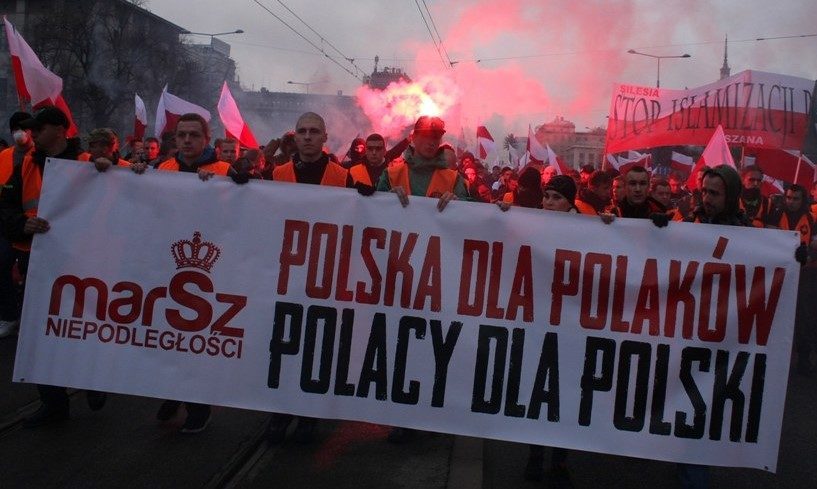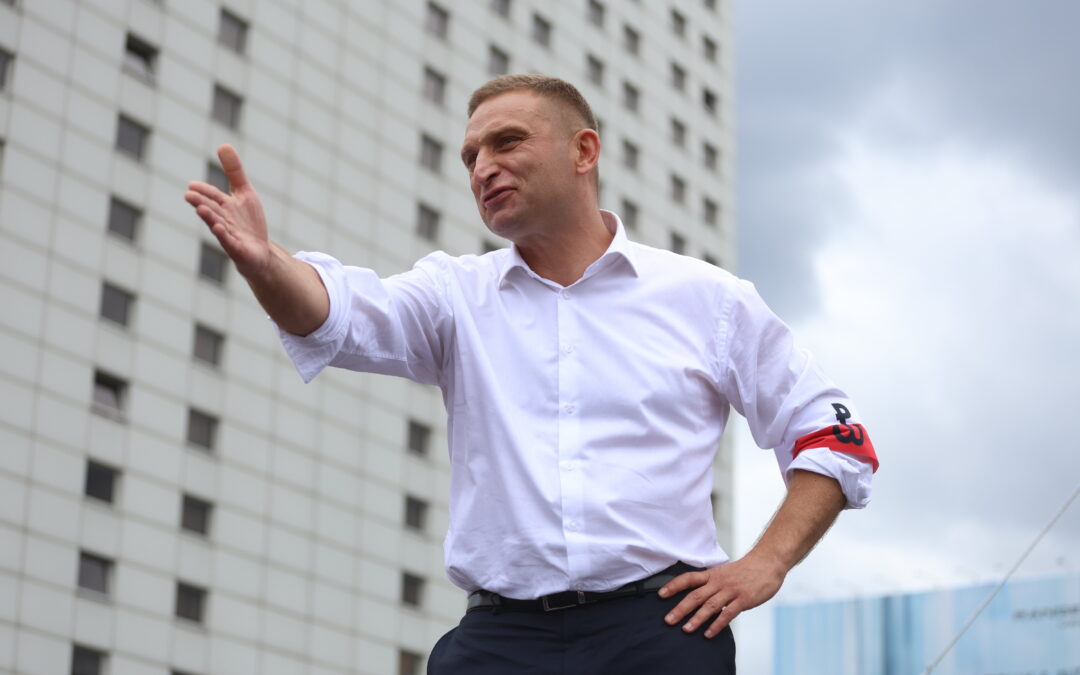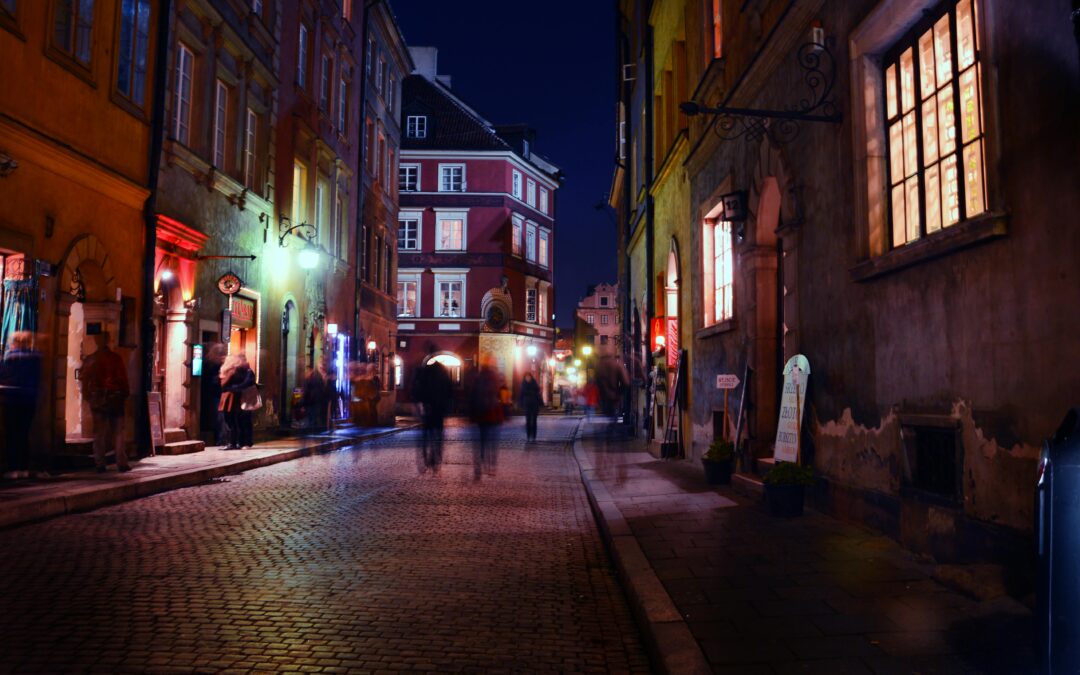By Stanley Bill
On Monday, the annual March of Independence (Marsz Niepodległości) will return to the streets of Warsaw, accompanied by its customary storm of controversy.
Last year’s event, celebrating 100 years since Poland regained independence, saw the participation of President Andrzej Duda, Prime Minister Mateusz Morawiecki, and senior members of Law and Justice (PiS), including leader Jarosław Kaczyński. Critics described their presence as the apotheosis of the ruling party’s mainstreaming of the far-right groups who organise the march. Around 250,000 Poles joined them in what became a triumph for the nationalist movement.
This year’s march will take place in very different circumstances. The organisers now effectively have their own presence in the parliament among the newly elected MPs of far-right Confederation (Konfederacja). In the October elections, PiS witnessed the very shift it was trying to avoid by coddling nationalists: the rise of a viable political force to its right.
This situation has changed the calculus for its approach to the march in 2019. At present, it seems unlikely that President Duda or high-ranking members of PiS will participate. Even last year, they sent out mixed messages before the event, reflecting their eternal dilemma between embracing the widest spectrum of the Polish right and staying closer to the centre.
This year’s march has already adopted a tone of stridently religious nationalism. Its official logo of a raised fist clenching a Roman Catholic rosary has drawn wide criticism, including from many conservatives and church authorities, who view it as a violent deformation of the Christian message.
Ten kto wpadł na pomysł wpisania różańca w symbol „white power” bardzo brzydko się bawi. pic.twitter.com/1bIBx1bP6k
— kataryna (@katarynaaa) October 18, 2019
Whatever happens on Monday, there is sure to be controversy. Much of it will focus on the line between patriotism and nationalism.
A nationalist march
The March of Independence is a nationalist event. Many “ordinary” marchers may see themselves as “patriots”, but the march has been conceived, shaped, organised and led by members of two radical nationalist groups: the National Radical Camp (ONR) and the All-Polish Youth (MW). All other marchers are participants in their event, which began in 2010 as a less-controlled spectacle, often featuring hooliganism and violence.
The official “guard” of the march is composed of members of these radical groups, many displaying nationalist symbols. The two main organisations have formed the overarching National Movement (RN), which is strongly represented at the march and is now part of Confederation in the parliament. The march has also featured a fringe of neo-Nazis and white supremacists, who created controversy in 2017 as the “Black Bloc”, with as many as 400 participants.
Beyond the march, some of the organisers have also been involved in agitation against what they view as a looming spectre of Jewish property restitution and against “Jewish” understandings of history. In 2018, they led a protest against PiS’s backdown on its so-called “Holocaust law”, urging President Duda to “take off his yarmulke” and telling Jews to “go back to Israel”.
A large nationalist protest against a US law relating to Jewish Holocaust-era property restitution took place today outside the prime minister's chancellery in Warsaw.
'This is Poland, not Polin,' chanted the crowd, referring to the Hebrew name for Poland https://t.co/MQAT34Yo4J
— Notes from Poland 🇵🇱 (@notesfrompoland) May 11, 2019
As the march has grown in popularity since PiS came to power, the core nationalists have been joined by many more so-called “normals”: traditional conservatives who do not self-identify as nationalists. In 2018, most of the marchers waved Polish flags, not nationalist symbols. Some families have even attended the march. Yet the atmosphere in large sections still evokes a football crowd, with raucous chanting in male voices, regular explosions, and the red glow of flares.
Both ONR and MW are reactivated versions of interwar radical nationalist organisations. ONR, in particular, was influenced by fascist ideas, styles and imagery in the 1930s. Some argue that the present-day group is a neo-fascist organisation by association. However, the group denies fascist links, even as it continues to draw on fascist-style imagery.
The symbol of the present-day National Radical Camp is that of the more radical wing of the interwar movement – the “Falanga”. The image depicts a stylised arm wielding a sword, ostensibly derived from a Polish navy insignia. However, the design of the symbol appears to reference the Nazi swastika of the time, and the symbol was worn on armbands by activists dressed in unmistakably National Socialist style.
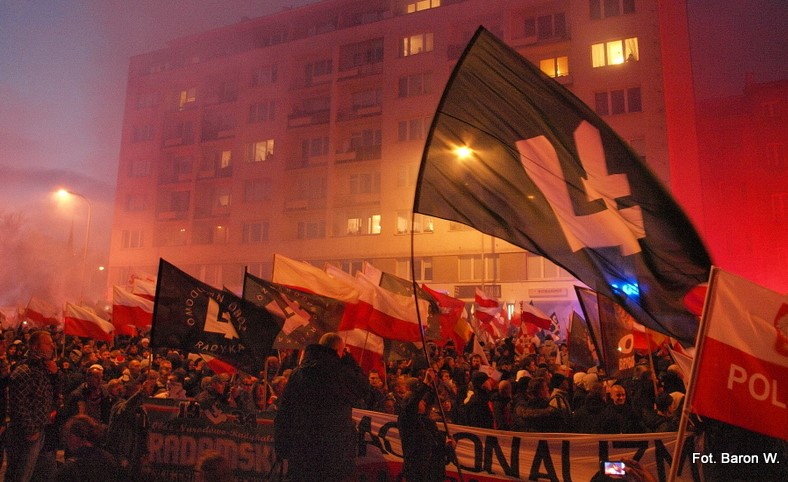
Image Credit: Wiktora Baron/Wikimedia Commons (under CC BY 3.0).
At the March of Independence, the “Falanga” symbol is prominent. ONR often leads the march, and its green flags flutter across the mass of people. Most of the key speeches at the march have also featured representatives of radical-nationalist groups, including far-right activists from Slovakia, Hungary and Italy. Roberto Fiore from the Italian Forza Nuova – who spoke at the march in 2017 and whose group was invited again last year – has referred to himself openly as a “fascist”. Though neo-Nazis, white supremacists and overt fascists may be in a small minority, the March of Independence is clearly a radical nationalist event.
Who is a nationalist?
So why do so many “normals” attend a radical-nationalist march if they are not nationalists themselves?
A 2016 study from the Public Opinion Research Centre (CBOS), entitled “Between Patriotism and Nationalism“, shows that Poles do not readily self-identify as “nationalists”, even when they espouse views that would usually be characterised as such. Only 7% of those surveyed in the study described themselves as “nationalists”. Yet 17% declared “support for the activities of such movements as ONR and MW”. Only 16% of those who supported these organisations self-identified as “nationalists”. And only 42% of self-described “nationalists” declared support for ONR and MW. In short, the majority of both self-identifying nationalists and non-nationalists simply did not see these groups as nationalist organisations.
The CBOS study also suggests that the very word “nacjonalista” (“nationalist”) has such negative associations in Polish that only the most radical are willing to self-define under this category. ONR and MW tend to describe themselves as “narodowcy”, a term with the same basic meaning as “nacjonalista”, but with a lighter connotation. It is difficult to render the distinction in English, but “narodowiec” (in the singular) is closer to expressions like “national activist”.
Members of ONR and MW still use the term “nacjonalista” frequently in informal communications, but they tend to avoid it in official declarations. Only the most extreme groups – for instance, those who carried racist banners at the march in 2017 – use the term “nacjonalista” with consistent pride.
The findings of the CBOS study help explain the outraged reactions in Poland to international media descriptions of the march as a manifestation of radical nationalism. While attending an event organised by groups that political scientists would define as “nationalist”, many marchers see themselves as “patriots” or supporters of “national activism”. The linguistic distinction is important, but a type of cognitive dissonance might also come into play.
Finally, the failure to recognise ONR and MW as radical-nationalist organisations shows the successful efforts of these groups to mainstream themselves, most recently with the tacit support of the PiS government.
Mainstreaming radical nationalism
The development of the March of Independence over the last nine years reflects the normalisation of nationalist discourse. From 2010, the march began to grow from the initiative of two fringe organisations into an event of wider significance partly as a focus of resistance to the centrist Civic Platform government of the time (the motto of the 2012 march was “Let’s win back Poland”). This anti-government message led to violence in the early years, but it also made the march appealing to the more radical “patriotic” circles loyal to PiS – for instance, the Smolensk catastrophe conspiracy-theory group Solidarni 2010.
Since the election of PiS in 2015, the March of Independence has expanded dramatically. It is no longer a radically anti-establishment event. The organisers have been diplomatic in their contacts with the government, despite differing views on various issues, and they no longer tolerate destruction of public property. In return, government representatives and the state media have promoted and praised the march, while playing down evidence of nationalist extremism.
In 2016, the government removed ONR’s interwar “Falanga” symbol from a list of those to be identified by police as connected with xenophobia and racism. In 2015, President Duda discontinued his predecessor’s presidential independence march, which had offered an alternative for those who wished to celebrate November 11 in a different way. Instead, he wrote congratulatory letters to the nationalists.
In general, the mainstream of PiS is not in close ideological accord with the march’s organisers. Kaczyński has espoused a more open concept of nation, condemning the interwar antisemitism of ONR. Yet there are PiS factions and voters with more nationalist views, which party leaders have cultivated. In 2018, Prime Minister Morawiecki appointed a former MW leader to a deputy-ministerial position. Justice minister Zbigniew Ziobro and his United Poland party – a junior partner in the government – also have links to nationalists.
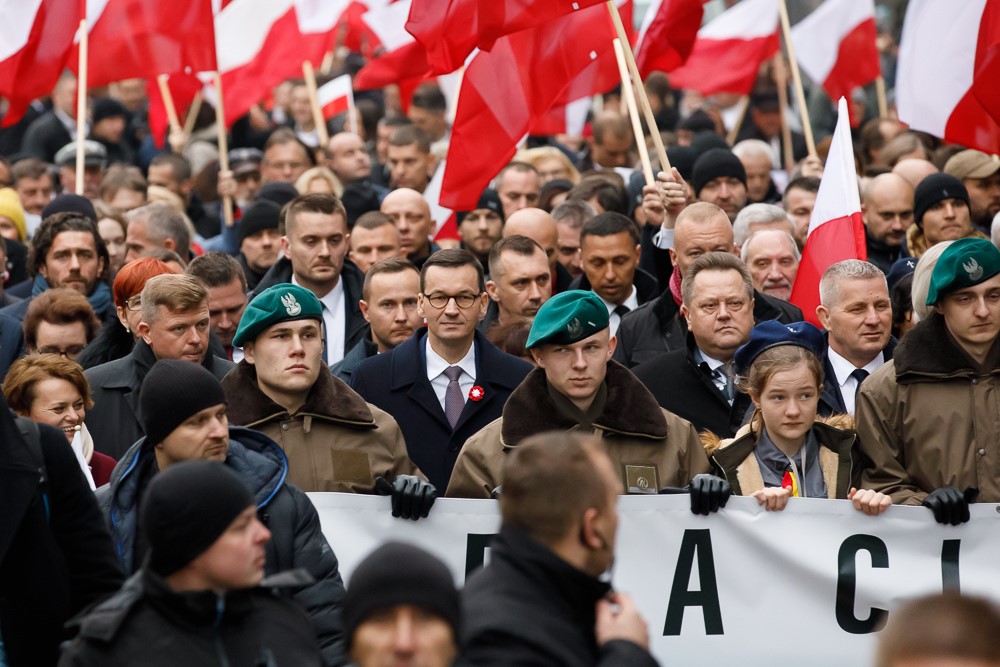
Image credit: Krystian Maj / Adam Guz / KPRM (Public Domain – Flickr).
Kaczyński’s political failures in the 1990s taught him that internal division is the greatest enemy of success for the right in Poland. Therefore, he has seen it as crucial for PiS to construct the broadest possible church and to appropriate any political ground to their right. Yet the recent entry of far-right Confederation into the parliament with 7% of the vote marks the failure of this strategy.
PiS has fallen victim to its own policy of indulging nationalists. Instead of protecting its right flank, the party has merely cultivated support for ideas that are now more directly represented by Confederation. Although the March of Independence is not formally linked to this far-right grouping, two of its MPs are former key members of the organising committee. PiS’s mainstreaming of the march has contributed to the radicals’ recent transformation from fringe-dwellers into a more coherent force in the parliament.
Nationalism remains a minority view in Poland. But thanks to PiS and the expansion of the March of Independence, Polish nationalists have gained new respectability and widened their support base. On November 11, they will celebrate their success once again on the streets of Warsaw.
Main image credit: Marsz Niepodległośći, Flickr/Piotr Drabik (under CC BY 2.0)

Stanley Bill is the founder and editor-at-large of Notes from Poland. He is also Professor of Polish Studies and Director of the Polish Studies Programme at the University of Cambridge. He has spent more than ten years living in Poland, mostly based in Kraków and Bielsko-Biała.
He is the Chair of the Board of the Notes from Poland Foundation.
